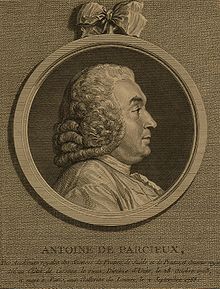- Antoine Deparcieux
-
Antoine Deparcieux (October 28, 1703 – September 2, 1768) was a French mathematician.
In 1746, Antoine Deparcieux (1703–1768) published Essai sur les probabilités de la durée de la vie humaine (An Essay on the Probabilities of the Duration of Human Life). Deparcieux analyzed in detail empirical observations. As a mathematician and physicist, he can be considered, after Halley and Struyck, one of the founders of the estimation of longevity and all the issues surrounding that concept.
Antoine Deparcieux was born in 1703 in Cessoux parish, Peyremale, a small village close to Nîmes in the south of France. His family was poor. His father, Jean-Antoine Deparcieux, and mother, Jeanne Donzel, were peasants. Jean-Antoine died when Antoine was only 12 years old, and his elder brother, Pierre, who was a carpenter, raised him. The parish priest of Peyremale provided Antoine’s early education before he attended the school of the Jesuits of Ale's. Although we know that he spent some time at their school in Lyon (around 1725) in exchange for his labour, little information exists about this period in his life.
Deparcieux came to Paris around 1730. He became the collaborator, then the secretary of the geometer De Montcarville, who was a member of the French Academy of Sciences and a teacher at the Collège de France. Montcarville played an important part in Deparcieux’s career. Apparently, Deparcieux improved his mathematical and mechanical knowledge under Montcarville’s guidance and eventually became his assistant at the Collège de France. Meanwhile, Deparcieux learned to construct sundials and had the Duke of Nevers among his customers.
After the publication of Treatise on Trigonometry and Gnomons (1741), Deparcieux was elected to membership in the Royal Society of Sciences of Montpellier. Moreover, after the publication of Essay on the Probabilities of the Duration of Human Life in 1746, he was received at the Royal Academy of Sciences of Paris.
Although this essay allowed him to enter the academy, he was admitted as a physicist and mechanical engineer. On January 12, 1746, he read his essay during a session of the academy. Two weeks later, he was proposed as adjoint-mécanicien at the same time as the famous Vaucanson, who got the post. On February 16, 1746, Deparcieux was elected as adjoint-géomètre, then promoted to associé-géomètre on May 16, 1756, succeeding d’Alembert, who had been elected pensionnaire-surnuméraire. Deparcieux became Royal Censor in 1765 and then obtained an apartment at the Louvre and a yearly allowance. Eventually, Deparcieux was elected pensionnaire-géomètre-surnuméraire on June 11, 1768, and also became a member of the academies of Berlin, Stockholm, Metz, and Lyon.
During the early years of his activities at the Royal Academy, Deparcieux invented several machines. He devised an engine that elevated water at Crécy castle, a pump for Arnouville castle, and at the administration's request, a press for the preparation of tobacco. His greatest project concerning the river Yvette (Canal de l’Ourcq) was implemented only during the first empire. Although he seemed ready to forsake mathematics for mechanics, in 1760 he returned to the probabilities of the duration of life and published an addition to his 1746 essay on the subject.
After a discussion during one session in March 1768, the longtime secretary of the Royal Academy of Sciences, Grandjean de Fouchy, was invited to write an abstract of annual population changes for History of the Academy. The presentation of Jean Morand's memoir, containing a compilation of baptismal, marriage, and death records in Paris, led to this decision. The academicians asked Deparcieux to gather such data for the entire century. Unfortunately, he suffered from palsy and rheumatism for several years and was already so ill at the time of this assignment that he died 6 months later, on September 1, 1768.
After Addition to the Essay was published in 1760, Deparcieux worked on the revision of Essay during the last months of his life. His colleagues at the academy asked Charles de Borda and Achille Pierre Dionis du Séjour (1734–1794) to examine the unfinished manuscript. They thought that the third part of the book, which was about annuities, should be improved. Although Borda promised to do so, a new edition never appeared.
In 1758, Deparcieux was elected a foreign member of the Royal Swedish Academy of Sciences.
Deparcieux never married and had no children, reportedly saying that he simply had no time for it. His nephew and namesake (1753–1799), who inherited a large cabinet de physique from his great uncle, published Deparcieux's Traité des annuite's ou des rentes à vie in 1781.
References
Much of the content of this article comes from the equivalent French-language Wikipedia article (retrieved September 16, 2005).
External links
- O'Connor, John J.; Robertson, Edmund F., "Antoine Deparcieux", MacTutor History of Mathematics archive, University of St Andrews, http://www-history.mcs.st-andrews.ac.uk/Biographies/Deparcieux.html.
- This article incorporates text from the public domain 1907 edition of The Nuttall Encyclopædia.
Categories:- French mathematicians
- Members of the Royal Swedish Academy of Sciences
- 1703 births
- 1768 deaths
Wikimedia Foundation. 2010.

